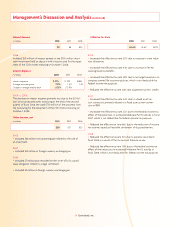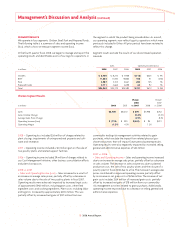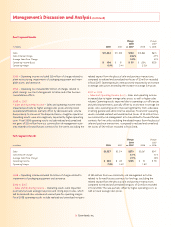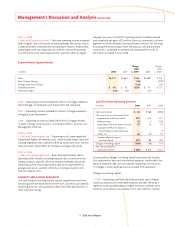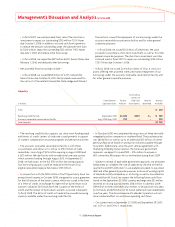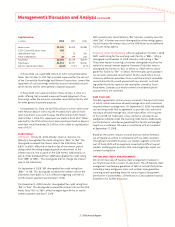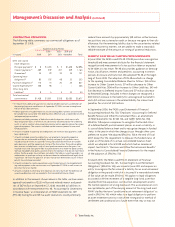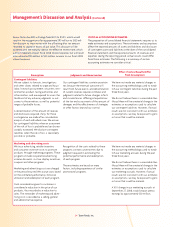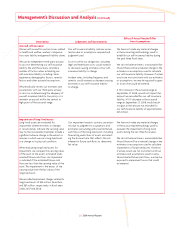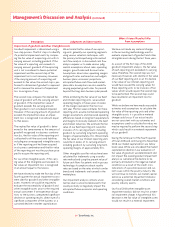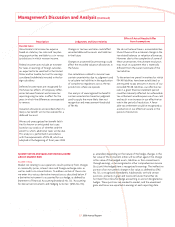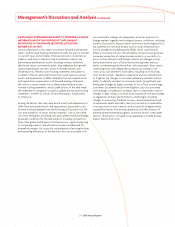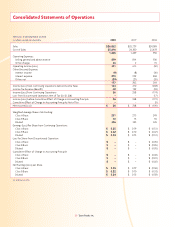Tyson Foods 2008 Annual Report Download - page 23
Download and view the complete annual report
Please find page 23 of the 2008 Tyson Foods annual report below. You can navigate through the pages in the report by either clicking on the pages listed below, or by using the keyword search tool below to find specific information within the annual report.
21 2008 Annual Report
Management’s Discussion and Analysis (continued)
Capitalization
in millions 2008 2007 2006
Senior notes $2,400 $2,475 $3,388
3.25% Convertible senior notes 458 – –
Lakeside term loan – 25 345
Other indebtedness 38 279 246
Total Debt $2,896 $2,779 $3,979
Total Equity $5,014 $4,731 $4,440
Debt to Capitalization Ratio 36.6% 37.0% 47.3%
• In fi scal 2008, we issued $458 million of 3.25% Convertible Senior
Notes due October 15, 2013. Net proceeds were used for the net cost
of the Convertible Note Hedge and Warrant Transactions, toward the
repayment of our borrowings under the accounts receivable securiti-
zation facility, and for other general corporate purposes.
• In fi scal 2008, we issued 22.4 million shares of Class A stock in a
public offering. Net proceeds were used toward repayment of our
borrowings under the accounts receivable securitization facility and
for other general corporate purposes.
• At September 30, 2006, we had $750 million in a short-term invest-
ment held on deposit with a trustee. Proceeds from sale of short-
term investment were used to repay the $750 million 7.25% Notes
due October 1, 2006. This repayment was made in fi scal 2007. When
adjusted for the $750 million short-term investment held on deposit,
total debt would have been $3.2 billion, with a debt to capitalization
ratio of 42.1%.
Credit Ratings
2016 Notes On July 24, 2006, Moody’s Investors Services, Inc.
(Moody’s) downgraded the credit rating from “Baa3” to “Ba1.” This
downgrade increased the interest rate on the 2016 Notes from
6.60% to 6.85%, effective on the fi rst day of the interest period
during which the rating change required an adjustment to the
interest rate (i.e., the issuance of the 2016 Notes). Additionally, on
July 31, 2006, Standard & Poor’s (S&P) downgraded the credit rating
from “BBB” to “BBB–.” This downgrade did not change the interest
rate on the 2016 Notes.
On September 4, 2008, S&P downgraded the credit rating from
“BBB–” to “BB.” This downgrade increased the interest rate on the
2016 Notes from 6.85% to 7.35%, effective beginning with the six
month interest payment due October 1, 2008.
On November 13, 2008, Moody’s downgraded the credit rating from
“Ba1” to “Ba3.” This downgrade increased the interest rate on the 2016
Notes from 7.35% to 7.85%, effective beginning with the six month
interest payment due April 1, 2009.
S&P currently rates the 2016 Notes “BB.” Moody’s currently rates this
debt “Ba3.” A further one-notch downgrade by either ratings agency
would increase the interest rates on the 2016 Notes by an additional
0.25% per ratings agency.
Revolving Credit Facility Rating After an upgrade on October 1, 2008,
S&P’s credit rating for the revolving credit facility is “BBB–.” After a
downgrade on November 13, 2008, Moody’s credit rating is “Ba2.”
The pretax impact to earnings of another downgrade would not be
material to annual interest expense. However, if Moody’s were to
downgrade this facility to “Ba3” or below, or if S&P were to down-
grade this facility to “BB–” or below, then the banks participating in
our accounts receivable securitization facility could refuse to pur-
chase any additional receivables from us and the accounts receivable
securitization facility could unwind with any amounts outstand-
ing under the facility repaid as the receivables owned by Tyson
Receivables Company, our wholly-owned consolidated special
purpose entity, are collected.
Debt Covenants
Our debt agreements contain various covenants, the most restrictive
of which contain maximum allowed leverage ratios and a minimum
required interest coverage ratio. On September 10, 2008, we amended
our revolving credit facility agreement to provide a less restrictive
maximum allowed leverage ratio, which takes effect in fi rst quarter
of fi scal 2009. All trademarks of our domestic subsidiaries are
pledged as collateral under the revolving credit facility. Additionally,
certain domestic subsidiaries guaranteed this facility and pledged
inventory as collateral. We were in compliance with all covenants
at September 27, 2008.
Based on the current industry outlook and our internal forecasts,
we anticipate we will be in compliance with our debt covenants
throughout fi scal 2009. However, our Chicken segment in the fi rst
part of fi scal 2009 will be negatively impacted by diffi cult export
markets and long grain positions that could negatively impact our
covenant compliance.
OFF-BALANCE SHEET ARRANGEMENTS
We do not have any off-balance sheet arrangements material to
our fi nancial position or results of operations. The off-balance sheet
arrangements we have are guarantees of debt of outside third parties,
including a lease and grower loans, and residual value guarantees
covering certain operating leases for various types of equipment.
See Note 9, “Commitments” of the Notes to Consolidated Financial
Statements for further discussion.





